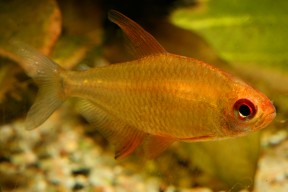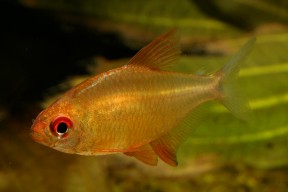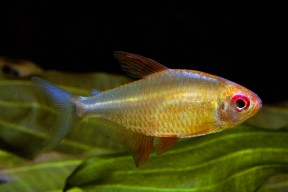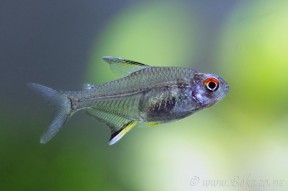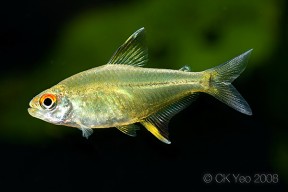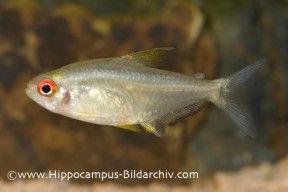Hyphessobrycon pulchripinnis
Lemon Tetra
Etymology
Hyphessobrycon: from the Ancient Greek υπελάσσων (hyphésson), meaning ‘of lesser stature’, used as a prefix in this case, plus the generic name Brycon.
pulchripinnis: from the Latin pulcher, meaning ‘beautiful’, and pinna, meaning ‘fin’, in reference to the black and yellow dorsal and anal fins.
Classification
Order: Characiformes Family: Characidae
Distribution
This species’ distribution is somewhat confusing. The type locality is vague (see below), and the majority of subsequent reports pertain to the rio Tapajós basins in central Brazil, one of the primary affluents of the lower Amazon River basin. The species is thus often assumed to be endemic to this watershed, but at least one field observation suggests that it also occurs in the rio Xingu system which borders the Tapajós to the east, and some have suggested that it may not occur in the Tapajós at all (see ‘Notes’).
Nevertheless, most records pertain to the middle and lower Tapajós in Pará state, between the municipalities of Belterra and Jacareacanga and downstream of the confluence between its two main tributaries, the rios Teles Pires (also known as rio São Manuel) and Juruena. There is also a report from the rio Kaiapá, a tributary of the Teles Pires located several hundred kilometres upstream in Mato Grosso state. In the Xingu system it has been recorded from a single igarapé in the lower basin, close to the municipality of Senador José Porfírio (formerly known as Sousel/Souzel).
Type locality is unclear since the species was described from aquarium specimens, and was given as ‘locality reportedly Amazonas’.
Habitat
Likely to favour minor tributaries, smaller rivers, oxbows, and flooded forests rather than main river channels.
Maximum Standard Length
35 – 40 mm.
Aquarium SizeTop ↑
An aquarium with base dimensions of 80 ∗ 30 cm or equivalent should be the smallest considered.
Maintenance
Perhaps looks best in an arrangement comprising a sandy substrate plus some driftwood roots and branches, or heavily-planted planted set-up.
The addition of dried leaf litter would further emphasise the natural feel and as well as offering additional cover for the fish brings with it the growth of microbe colonies as decomposition occurs.
The latter are useful since they provide an additional food source for both adults and fry while the humic substances released by decaying leaves are also considered beneficial.
Water Conditions
Temperature: 20 – 28 °C
pH: 5.0 – 7.5
Hardness: 18 – 215 ppm
Diet
Probably omnivorous feeding on small invertebrates, crustacea, filamentous algae, fallen fruit, and suchlike in nature.
In aquaria it may survive on a diet of dried foods but like most fishes does best when offered a varied menu which in this case should also contain live and frozen chironomid larvae (bloodworm), mosquito larvae, Daphnia, Moina, etc.
Behaviour and CompatibilityTop ↑
Very peaceful making it an ideal resident of the well-researched community aquarium.
It is perhaps best-maintained alongside similarly-sized characids, gasteropelecids, lebiasinids, smaller callichthyid or loricariid catfishes and non-predatory, small-to-medium-sized cichlids.
Try to buy a mixed-sex group of at least 8-10 specimens since this species forms temporary dominance hierarchies within which males compete for female attention, and therefore displays more interesting behaviour and better colouration when maintained in numbers.
Sexual Dimorphism
Adult males tend to be less deep-bodied, slightly smaller, and more intensely-coloured than females, particularly in the dorsal and anal fins.
Reproduction
An egg-scattering free spawner exhibiting no parental care.
When in good condition adults will spawn often and in a mature aquarium it is possible that small numbers of fry may start to appear without intervention, but if you want to maximise yield a more controlled approach is required.
The adult group can still be conditioned together but a smaller aquarium should also be set up and filled with mature water. This should be very dimly lit and the base covered with some kind of mesh of a large enough grade so that the eggs can fall through but small enough so that the adults cannot reach them. The widely available plastic ‘grass’-type matting can also be used and works well, as does a layer of glass marbles. Alternatively, filling much of the tank with a fine-leaved plant such as Taxiphyllum spp. or spawning mops can also return decent results.
The water itself should be of slightly acidic to neutral pH with a temperature towards the upper end of the range suggested above. An air-powered sponge filter or air stone(s) should also be included to provide oxygenation and water movement.
When the adult fish are well-conditioned a single pair or group comprising one or two males and several females can then be introduced to each container and left in place until eggs are detected (typically the following morning).
Initial food should be Paramecium or a proprietary dry food of sufficiently small (5-50 micron) grade, introducing Artemia nauplii, microworm, etc., once the fry are large enough to accept them.
NotesTop ↑
This species is a popular aquarium fish and is bred on a commercial basis in several countries, with a selectively-bred albino form also available.
Wild specimens are rarely collected due to the low price of the farmed fish, but the origin of the commercial strain is questionable. The species was considered endemic to the rio Tapajós basin, but in the early 1990s fish appearing identical to the aquarium form were photographed in their natural habitat in the lower rio Xingu basin. In addition, a clearly related form has repeatedly been collected from the rio Tapajós basin since the 1970s and was identified as H. pulchripinnis by Géry (1980).
The latter fish is referred to as H. pulchripinnis ‘orange red’ or the rather misleading ‘orange Bolivia’ in the aquarium hobby, and its identification as H. pulchripinnis established the assumption that the species is native to the Tapajós. The two forms may not be conspecific, however, since they exhibit a number of differences in colour pattern and morphology.
Specifically, the aquarium ‘lemon’ form differs from the orange red’ form in the following characters: base body colour greenish-yellow (vs. orange-yellow); anterior dorsal-fin rays black with milky tips, anterior anal-fin rays mostly yellowish (vs. anterior dorsal and anal-fin rays orange-red, blackish distally); upper portion of eye orange-red (vs. eye almost entirely intense red); diffuse humeral spot rarely (vs. commonly) visible; males without (vs. with) extended dorsal-fin.
The two forms are very similar in terms of dentition and meristics (Zarske, 2008) therefore it is unclear whether they represent distinct species or not, while their natural distributions also remain in question. Some fish entering the aquarium trade also appear intermediate between the two colour forms (see images attached to this profile), therefore all are included together here on SF until the confusion is resolved.
H. pulchripinnis was included in the putative H. callistus group of closely-related species within the genus as proposed by Géry (1977, see below) of which members are characterised by possession of a prominent dark spot on the dorsal-fin, usually with a white or yellow marking beneath. As a result, they are sometimes referred to collectively as ‘flag tetras’.
Within this artificial assemblage, H. pulchripinnis was distinguished by possession of a relatively small dorsal-fin spot, present only on the anterior two rays and forming a band with a distal yellow spot on the tips of these rays. The anal-fin exhibits a similar pattern on the anterior few rays, with a black border posteriorly.
Hyphessobrycon was raised by Durbin in Eigenmann (1908) as a subgenus of Hemigrammus, differing from the latter by the absence of scales on the caudal-fin.
The grouping was revised by Eigenmann (1918, 1921) while Géry (1977) created artificial groups of species based on colour pattern, and these definitions are still widely used today, e.g., the H. agulha group, the H. heterohabdus group, etc. These cannot be considered to represent monophyletic assemblages, however, and their concepts continue to be redefined.
Weitzman & Palmer (1997) hypothesised the existence of a monophyletic assemblage within the genus based on colour pattern and male fin morphology that they termed the ‘rosy tetra clade’, with one of the characters supporting its monophyly being presence of a prominent dark marking on the dorsal-fin. This assemblage, plus other morphologically similar species, is considered to represent Hyphessobrycon sensu stricto by some authors, with the remaining species included in a much-expanded H. heterohabdus group.
Others have proposed conflicting, typically more restricted, views of both the genus and/or its constituent species groups, and significant confusion remains. What is clear is that, as currently recognised, Hyphessobrycon is a polyphyletic lineage containing several genera.
The process of splitting it up has already started, and Malabarba et al. (2012) revalidated the genus Ectrepopterus Fowler, previously considered a synonym of Hyphessobrycon. They also analysed its relationships within the Characidae in the context of Mirande’s (2010) previous work, but included the type species, H. compressus, for the first time in such a study. The results demonstrated that H. compressus is more closely-related to ‘rosy tetra’ representatives such as H. eques, H. pulchripinnis, and H. socolofi than other members of the genus including H. anisitsi, H. bifasciatus, H. elachys, H. herbertaxelrodi, and H. luetkeni.
References
- Ahl, E., 1937 - Zoologischer Anzeiger 120(9/10): 235-236
Über einen neuen südamerikanischen Characiniden der Gattung Hyphessobrycon. - Calcagnotto, D., S. A. Schaefer, and R. DeSalle, 2005 - Molecular Phylogenetics and Evolution 36(1): 135-153
Relationships among characiform fishes inferred from analysis of nuclear and mitochondrial gene sequences. - Camargo, M., T. Giarrizzo, and V. Isaac, 2004 - Ecotropica 10: 123-147
Review of the geographic distribution of fish fauna of the Xingu river basin, Brazil. - Carvalho, T. P. and V. A. Bertaco, 2006 - Neotropical Ichthyology 4(3): 301-308
Two new species of Hyphessobrycon (Teleostei: Characidae) from upper rio Tapajós basin on Chapada dos Parecis, Central Brazil. - Géry, J., 1977 - T. F. H. Publications, Inc.: 1-672
Characoids of the world. - Malabarba, L. R., V. A. Bertaco, F. R. Carvalho & T. O. Litz., 2012 - Zootaxa 3204: 47-60
Revalidation of the genus Ectrepopterus Fowler (Teleostei: Characiformes), with the redescription of its type species, E. uruguayensis. - Mirande, J. M., 2010 - Neotropical Ichthyology 8(3): 385-568
Phylogeny of the family Characidae (Teleostei: Characiformes): from characters to taxonomy. - Oliveira, C. A., G. S. Avellino, K. T. Abe, T. C. Mariguela, R. C. Benine, G. Orti, R. P. Vari, and R. M. Corrêa e Castro, 2011 - BMC Evolutionary Biology 11(1): 275-300
Phylogenetic relationships within the speciose family Characidae (Teleostei: Ostariophysi: Characiformes) based on multilocus analysis and extensive ingroup sampling. - Reis, R. E., S. O. Kullander and C. J. Ferraris, Jr. (eds), 2003 - EDIPUCRS, Porto Alegre: i-xi + 1-729
Check list of the freshwater fishes of South and Central America. CLOFFSCA. - Weitzman, S. H. and L. Palmer, 1997 - Ichthyological Exploration of Freshwaters 7(3): 209-242
A new species of Hyphessobrycon (Teleostei: Characidae) from the Neblina region of Venezuela and Brazil, with comments on the putative `rosy tetra clade'. - Zarske, A., 2014 - Vertebrate Zoology 64(2): 139-167
Zur Systematik einiger Blutsalmler oder "Rosy Tetras" (Teleostei: Ostariophysi: Characidae). - Zarske, A., 2008 - Aquaristik-Fachmagazin 203: 32-34
Variationen in orange und grüngeld - der Zitronensalmler. - Zarske, A. and J. Géry, 1995 - Mitteilungen aus dem Zoologischen Museum in Berlin 71(1): 103-120
Zum Status der von E. Ahl aufgestellten Salmler-Taxa (Teleostei: Characidae).


